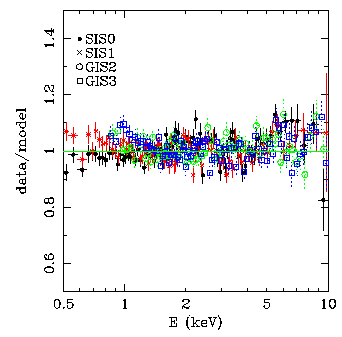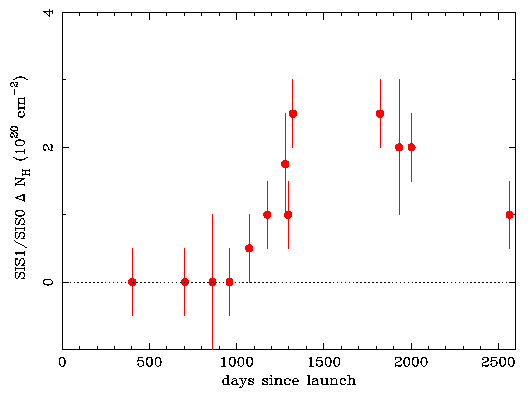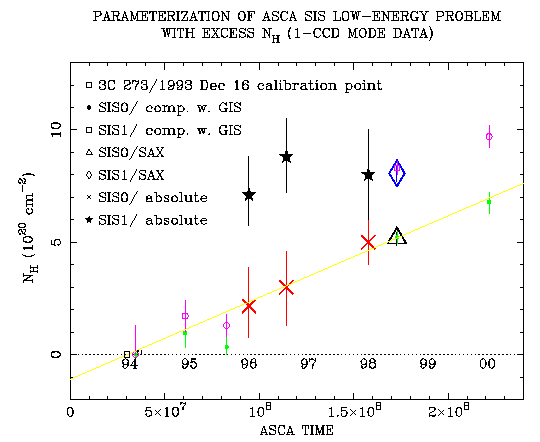Degradation of Low-Energy Degradation of SIS in 1-CCD mode
This document is a summary of
ASCA GOF Calibration Memo
[ASCA-CAL-00-06-01, v1.0 (06/05/00): T. Yaqoob \& ASCA Team])
in which full details of the following results can be found.
The low-energy response of both SIS
has been degrading both in effciency and energy resolution.
Whilst some of this degradation is corrected by the tool CORRECTRDD
a significant problem remains and results in an apparent divergence
of the the SIS response compared to the GIS at low energies
(see Fig. 1). The problem is likely to be related to the increase of
dark current and decrease of charge transfer efficiency (CTE) and is
the subject of on-going investiagtion by the
ASCA team.
Until this problem is fixed, we can try to quantify the apparent
loss in SIS low-energy efficiency as a function of
time throughout the mission, which will also help to understand
and model the degradation. Indeed such a parameterization
should help to get the correct form of the time-dependence
of the eventual model.
| Fig. 1a: 3C 273 1993/d 160 |
Fig. 1b: 3C 273 2000/d 9-10 |
 |
 |
Time Dependence and Magnitude of the Apparent SIS Degradation
We summarize the results of an investigation into the time-dependence of
the SIS degradation. See full report for details.
We can very crudely characterize the apparent loss in low-energy
efficiency as an excess absorption, or "excess NH."
The (model-independent) ratio of SIS-1/SIS-0 spectra shows
non-montonic behavior superimposed upon an overall trend in which
SIS-1 became significantly worse than SIS-0 over a few months in
late 1995/early 1996 - see Fig. 2.
We identified a number of observations suitable for quantifying
the absolute magnitude of the effect and the results, in
terms of the "excess NH" parameterization are shown in
Fig. 3.
The time-dependence for SIS-0 appears to be consistent with a linear
relation but that for SIS-1 is more complicated.
Specifically we find that a good approximation for the
"excess NH" for SIS0 is
NH(SIS-0) = 3.635857508e-8(T-3.0174828e7) e20 cm-2
where T is ASCA time
(seconds since 1993, Jan 1 take the average of the start and stop times of
your observation). For SIS-1, we suggest that you measure the SIS-1/SIS-0
spectral ratio of the actual data from your observation. If the signal-to-noise
of your data is not good enough to do this, then you need not worry
about "correcting" your data since statistical errors will domainate.
You should be warned that the "excess NH"
parameterization should
only be used to quantify the degradation of your data and should not
be used to apply a spectral correction since the intrepration of
spectral features may then be incorrect.
It appears that the spectral ratio of SIS-1/SIS-0 is
similar for 1-CCD and 2-CCD modes, even though the absolute degradation
for 2-CCD mode is worse that that for 1-CCD mode.
Fig. 2: The excess effective column density derived from
SIS-1/SIS-0 ratios.
Fig. 3: Derived effective "excess NH"
versus ASCA time.
This file was last modified on Monday, 30-Jul-2001 18:17:25 EDT
Curator:
Michael Arida (SP Sys); arida@milkyway.gsfc.nasa.gov
HEASARC Guest Observer Facility
If you have any questions concerning ASCA, visit
our Feedback form.





